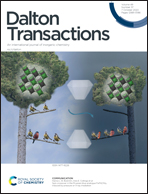Exploratory studies on azido-bridged complexes (Ni2+ and Mn2+) as dual colourimetric chemosensors for S2− and Ag+: combined experimental and theoretical outcomes with real field applications†
Abstract
We report two isostructural dinuclear transition metal complexes [M2(HL)2(N3)4], where M = Ni2+ (BS-1), Mn2+ (BS-2), and HL is (2-methyl-2-((pyridin-2-ylmethyl)amino)propan-1-ol) and investigate them as molecular sensors towards hazardous entities. BS-1 shows high selectivity towards the S2− and Ag+ ions, easily observed by the naked eye colour change and its detection limit in aqueous solutions for the S2− ion was calculated as 0.55 μM with a binding constant of 3.28 × 105 M−1, while the limit for the Ag+ ion is 21.8 μM. Notably, BS-2 shows good selectivity towards the Ag+ ion with a detection limit of 10.84 μM. Spectroscopic and DFT studies shed light on the mechanistic course of interaction between the host and guest entities, suggesting a sulphide-mediated reduction of the azide mechanism. In a nutshell, these simple transition metal complexes were exploited for discriminately detecting hazardous analytes with real field applications in analytical science (via. “Dip-Stick” approach) as well as engineering science, which provides a significant contribution in the recent advancement of supramolecular chemistry.



 Please wait while we load your content...
Please wait while we load your content...